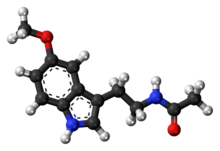褪黑素:修订间差异
无编辑摘要 |
|||
| 第84行: | 第84行: | ||
==功效== |
==功效== |
||
| ⚫ | 在动物中,褪黑激素参与同步昼夜节律,包括睡眠 - 觉醒时间、血压调节和季节性繁殖。它的大部分作用是激活褪黑激素受体,而另一部分则是它作为抗氧化剂的作用。在植物中,它具有抵抗氧化应激的作用<ref name="CBB21146" />,还可促进[[种子]]萌发、调节植物的碳氮代谢、[[果实]]发育以及改善果实品质和产量<ref>{{cite journal |last1=Erdal |first1=Serkan |title=Melatonin promotes plant growth by maintaining integration and coordination between carbon and nitrogen metabolisms |journal=Plant Cell Reports |date=2019-08 |volume=38 |issue=8 |pages=1001–1012 |doi=10.1007/s00299-019-02423-z}}</ref>。褪黑激素也存在于各种食物中。但中央神經系統才是控制[[內分泌系統]]及[[旁分泌|旁泌性系統]]的主要組織(曾經被人誤認為褪黑素)<ref name="Richardson2005">{{cite journal en |
||
===生理時鐘=== |
|||
| ⚫ | |||
|author = Richardson G |
|author = Richardson G |
||
|title = The human circadian system in normal and disordered sleep. |
|title = The human circadian system in normal and disordered sleep. |
||
2022年8月1日 (一) 09:24的版本
 | |
 | |
| 臨床資料 | |
|---|---|
| AHFS/Drugs.com | 消费者药物信息 |
| 给药途径 | 口服、舌下、皮肤 |
| ATC碼 | |
| 法律規範狀態 | |
| 法律規範 |
|
| 藥物動力學數據 | |
| 生物利用度 | 30–50% |
| 药物代谢 | 肝脏 via CYP1A2 mediated 6-hydroxylation |
| 生物半衰期 | 35–50 分钟 |
| 排泄途徑 | 肾脏 |
| 识别信息 | |
| |
| CAS号 | 73-31-4 |
| PubChem CID | |
| IUPHAR/BPS | |
| DrugBank | |
| ChemSpider | |
| UNII | |
| KEGG | |
| ChEBI | |
| ChEMBL | |
| CompTox Dashboard (EPA) | |
| ECHA InfoCard | 100.000.725 |
| 化学信息 | |
| 化学式 | C13H16N2O2 |
| 摩尔质量 | 232.278 g/mol |
| 3D模型(JSmol) | |
| |
| |
褪黑素,或称褪黑激素、松果体素或美拉托宁,化学名为N-乙酰基-5-甲氧基色胺[1],是一种生命必需的小分子吲哚胺类物质[2],在动物、植物、真菌和细菌中皆有发现。在动物体内,褪黑素是一种调节生物钟的激素[3];而其作用在其他生物体内可能不同,同样,褪黑素在动物体内的合成过程也不同于其他物种[4]。
褪黑素可以用来帮助入睡和治疗睡眠障碍。其可以口服也可以通过喷雾或透皮贴剂的方式给药。褪黑素在美国和加拿大是非处方药,在中国大陆为保健食品(如脑白金的主要成分),在台灣是未經政府許可的藥物[5] [6]。在其他的一些国家,褪黑素可能需要凭处方使用,或者不可用。
发现
20世纪初,人们发现有一种物质可以使蛙皮肤中的黑色素褪变成白色[2]。1958年从牛的松果体内分离提取出了该物质,并命名为褪黑素[7]。
开始人们普遍认为褪黑素仅在动物体内存在。随着研究的深入,才发现褪黑素在细菌、微生物、真菌、藻类以及植物中也存在[8]。
褪黑素的產生
在高等動物中,褪黑素是由松果體中的松果體細胞将色氨酸在4种酶的作用下经4步连续酶促反应转化而成[9]。松果體產生的褪黑素是內分泌激素,会进入血液;視網膜和胃腸道則產生旁泌性激素。下丘腦的視交叉上核會由視網膜接收每日光暗的規律,從而影響褪黑素的製造。
植物体内的褪黑素也是由色氨酸经过4步连续酶促反应转化而成, 但至少需要6种酶的参与[10]。
在人体内,5-羟色胺(又称为血清素)在N-乙酰基转移酶催化下与乙酰辅酶A反应转化为N-乙酰-5-羟色胺,然后N-乙酰-5-羟色胺再在乙酰血清素O-甲基转移酶催化下被S-腺苷甲硫氨酸甲基化为褪黑素。
有些植物,例如稻米,也會製造褪黑素,哺乳類動物進食含有褪黑素的食物後,褪黑素會被吸收,溶入體內的褪黑素[11][12]。
功效
在动物中,褪黑激素参与同步昼夜节律,包括睡眠 - 觉醒时间、血压调节和季节性繁殖。它的大部分作用是激活褪黑激素受体,而另一部分则是它作为抗氧化剂的作用。在植物中,它具有抵抗氧化应激的作用[2],还可促进种子萌发、调节植物的碳氮代谢、果实发育以及改善果实品质和产量[13]。褪黑激素也存在于各种食物中。但中央神經系統才是控制內分泌系統及旁泌性系統的主要組織(曾經被人誤認為褪黑素)[14][15]。
製造機制
在正常情況下,由视网膜感知环境中的蓝光亮度,给出的光暗信号传递给松果體,令其在黑暗的情況下製造褪黑素,因此褪黑素亦稱「黑暗荷爾蒙」。褪黑素的分泌於晚間中段時間最多,然後在晚間後段時間較少、再隨時間逐漸減少至天明。在古代,在溫帶生活的人於冬季會有十到八小時生活在黑暗當中,而篝火和白炽灯的光中蓝光的成分很少;反之,現代人广泛使用日光灯,身處黑暗的時間減至八小時以下。即使是微弱的燈光下褪黑素的產生都會受到一定程度的影響,在強光下的影響就更大。缺乏褪黑素被認為很可能是夜班工作者得癌病的成因[16],而現代於晚間亮燈的習慣亦被認為是发达國家越來越多人得癌症的原因之一[17]。
参见
参考文献
- ^ Melatonin. Sleepdex. [17 August 2011]. (原始内容存档于2015-09-24).
- ^ 2.0 2.1 2.2 Liu, Deshuai; Yao, Lei; Xu, Weirong; Feng, Mei; Yao, Wenkong. Research Progress of Melatonin in Plant Stress Resistance. Chinese Bulletin of Botany. 2022-01-01, 57 (1): 111. doi:10.11983/CBB21146.
- ^ Hardeland, Rüdiger; Pandi-Perumal, S.R.; Cardinali, Daniel P. Melatonin. The International Journal of Biochemistry & Cell Biology. 2006, 38 (3): 313–316. PMID 16219483. doi:10.1016/j.biocel.2005.08.020.
- ^ Lewis, Alan. Melatonin and the Biological Clock. McGraw-Hill. 1999: 7. ISBN 0879837349 (英语).
- ^ 國內市尚未開放…褪黑激素是禁藥 偷賣將遭重罰 - 生活 - 自由時報電子報 (页面存档备份,存于互联网档案馆),2016-04-25
- ^ 存档副本. [2022-02-22]. (原始内容存档于2022-02-22).
- ^ Lerner, Aaron B.; Case, James D.; Takahashi, Yoshiyata; Lee, Teh H.; Mori, Wataru. ISOLATION OF MELATONIN, THE PINEAL GLAND FACTOR THAT LIGHTENS MELANOCYTES 1. Journal of the American Chemical Society. 1958-05, 80 (10): 2587–2587. doi:10.1021/ja01543a060.
- ^ Tan, Dun-Xian; Manchester, Lucien C.; Hardeland, Rüdiger; Lopez-Burillo, Silvia; Mayo, Juan C.; Sainz, Rosa M.; Reiter, Russel J. Melatonin: a hormone, a tissue factor, an autocoid, a paracoid, and an antioxidant vitamin: Melatonin: a multi-functional molecule. Journal of Pineal Research. 2003-01, 34 (1): 75–78. doi:10.1034/j.1600-079X.2003.02111.x.
- ^ Fernández-Mar, M.I.; Mateos, R.; García-Parrilla, M.C.; Puertas, B.; Cantos-Villar, E. Bioactive compounds in wine: Resveratrol, hydroxytyrosol and melatonin: A review. Food Chemistry. 2012-02, 130 (4): 797–813. doi:10.1016/j.foodchem.2011.08.023.
- ^ Back, Kyoungwhan; Tan, Dun-Xian; Reiter, Russel J. Melatonin biosynthesis in plants: multiple pathways catalyze tryptophan to melatonin in the cytoplasm or chloroplasts. Journal of Pineal Research. 2016-11, 61 (4): 426–437. doi:10.1111/jpi.12364.
- ^ Hattori A, Migitaka H, Iigo M, Itoh M, Yamamoto K, Ohtani-Kaneko R, Hara M, Suzuki T, Reiter R. Identification of melatonin in plants and its effects on plasma melatonin levels and binding to melatonin receptors in vertebrates.. Biochem Mol Biol Int. 1995, 35 (3): 627–34. PMID 7773197.
- ^ Uz T, Arslan A, Kurtuncu M, Imbesi M, Akhisaroglu M, Dwivedi Y, Pandey G, Manev H. The regional and cellular expression profile of the melatonin receptor MT1 in the central dopaminergic system.. Brain Res Mol Brain Res. 2005, 136 (1-2): 45–53. PMID 15893586.
- ^ Erdal, Serkan. Melatonin promotes plant growth by maintaining integration and coordination between carbon and nitrogen metabolisms. Plant Cell Reports. 2019-08, 38 (8): 1001–1012. doi:10.1007/s00299-019-02423-z.
- ^ Richardson G. The human circadian system in normal and disordered sleep.. J Clin Psychiatry. 2005,. 66 Suppl 9: 3–9; quiz 42–3. PMID 16336035.
- ^ Perreau-Lenz S, Pévet P, Buijs R, Kalsbeek A. The biological clock: the bodyguard of temporal homeostasis.. Chronobiol Int. 2004, 21 (1): 1–25. PMID 15129821.
- ^ Schernhammer E, Rosner B, Willett W, Laden F, Colditz G, Hankinson S. Epidemiology of urinary melatonin in women and its relation to other hormones and night work.. Cancer Epidemiol Biomarkers Prev. 2004, 13 (62): 936–43. PMID 15184249.
- ^ Pauley S. Lighting for the human circadian clock: recent research indicates that lighting has become a public health issue.. Med Hypotheses. 2004, 63 (4): 588–96. PMID 15325001.
外部連結
- Melatonin information(页面存档备份,存于互联网档案馆) from MedlinePlus
- Melatonin entry in TiHKAL • info(页面存档备份,存于互联网档案馆)
| |||||||||||||||||||||||||||||||||||||||||||||
| ||||||||||||||||||||||||||||||||||||||||||||||||||||||||||||||||||||||||||||||||||||||||||||||||||||||||||||||||||||||||||||||||||||||||||
| ||||||||||||||||||||||||||||||||||||||||||||||
| ||||||||||||||||||||||||||||||||||||||||||||||||||
| |||||||||||||||||
| ||||||||||||
| ||||||||||||||||||||||||||||||||||||||||||||||||||||||||||||||||||||||||||||||||||||||||||||||||||||||||||||||||||||||||||||||||
|
